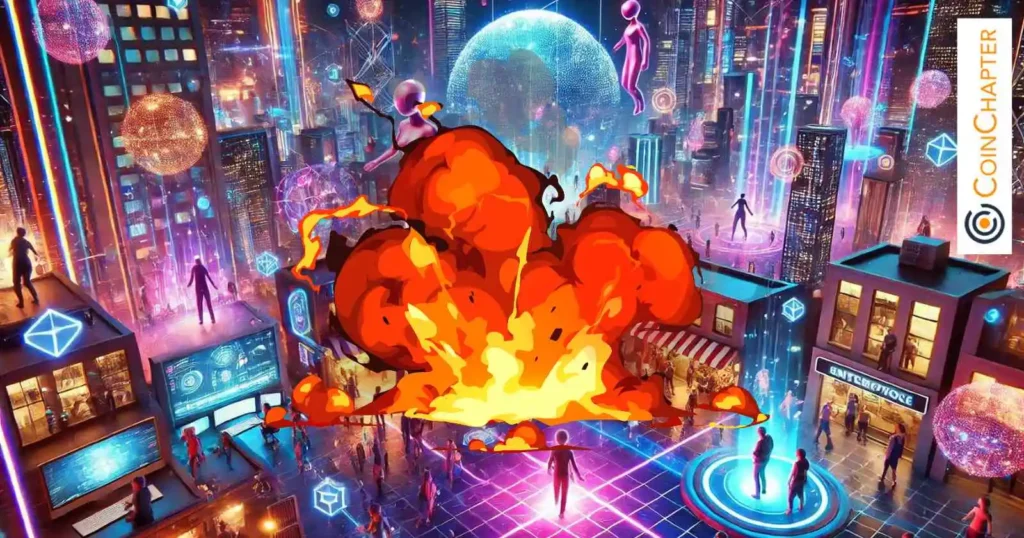NEW DELHI (CoinChapter.com) – In recent years, the tech world showed excitement surrounding the concept called the metaverse. This concept promised to transform online experiences, offering immersive virtual worlds where we could work, play, and socialize in ways never before imagined. Tech giants and investors poured billions into this vision, with Meta (formerly Facebook) leading the charge. However, recent data suggests that the metaverse bubble may have burst, leaving many to question its future.
To understand the current situation, we need to step back and look at what the metaverse promised. Imagine a virtual universe where you could attend concerts, shop in digital malls, or have meetings with colleagues from around the world, all while feeling as if you were truly present. This wasn’t just science fiction; it was pitched as the next evolution of the internet.
Mark Zuckerberg, CEO of Meta, became the face of this movement, rebranding his company and investing heavily in virtual reality technology. Researchers at Citi even projected that the metaverse could attract five billion users and grow to a $13 trillion market. These lofty predictions fueled a gold rush, with companies and individuals scrambling to stake their claim in this digital frontier.

The Metaverse’s Steep Decline
Fast forward to today, and the picture looks quite different. Meta’s ambitious metaverse division, Reality Labs, has been hemorrhaging money. In the last quarter alone, it lost $4.5 billion, contributing to a total loss of over $46 billion since its inception. These figures are a far cry from the profitable future once envisioned.
Even more telling is the fate of Horizon Worlds, Meta’s flagship metaverse platform for adults. Despite significant marketing efforts, it has struggled to attract its intended audience. Ironically, it has found unexpected popularity among children, a demographic it wasn’t designed for.
The Crypto Metaverse Crash
The metaverse concept wasn’t limited to traditional tech companies. A whole ecosystem of crypto-based virtual worlds emerged, promising decentralized ownership and unique digital assets. These platforms, built on blockchain technology, saw incredible hype and astronomical valuations. However, they too have experienced a dramatic downturn.
Take The Sandbox, for example. Once valued at over $7 billion, this virtual world has seen its daily transaction volumes plummet by an astonishing 99.9%. Where it once saw $117 million in transactions at its peak, it now struggles to reach $8,000 on an average day.

This isn’t an isolated case. Decentraland, another pioneering crypto metaverse, has witnessed a similar 99.9% decline in daily transactions, dropping from $2.5 million at its height to less than $5,000 today.
The Fall of Digital Assets
One of the most hyped aspects of these virtual worlds was the ability to own and trade digital assets, often in the form of non-fungible tokens (NFTs). These could represent anything from virtual real estate to in-game items. During the peak of the metaverse craze, these assets commanded eye-watering prices. Now, their value has all but evaporated.
In The Sandbox, NFT sales that once reached $10.2 million in a single day now struggle to surpass $10,000. This pattern repeats across other platforms, with Axie Infinity, once a poster child for play-to-earn gaming, seeing its trading volumes nosedive from nearly $1 billion to less than $2 million.
Cryptocurrencies linked to these metaverse projects haven’t fared any better. Tokens like MANA (Decentraland), SAND (The Sandbox), and AXS (Axie Infinity) have all seen their values plummet by over 90% since their peak in November 2021.

This decline isn’t just about individual projects; the entire metaverse crypto sector has shrunk significantly, with its combined market capitalization falling from $50 billion to $16 billion.
You May Also Like: Disney and Epic Games Partner to Create Metaverse-Like Game With Roots in Fortnite
What Factors Led to This Collapse?
Several factors have contributed to this rapid decline. First, the initial hype created unrealistic expectations. The technology required to deliver truly immersive, seamless virtual experiences is still in its infancy. Many users found the current offerings clunky and underwhelming compared to the promised vision.
Moreover, the concept itself may have been too abstract for mainstream adoption. While tech enthusiasts were excited, average internet users struggled to see how the metaverse would meaningfully improve their digital lives. The high cost of entry, both in terms of hardware and the learning curve, further limited adoption.
The broader economic downturn and crypto market crash also played a significant role. As investment capital became more scarce and risk appetite diminished, many metaverse projects found themselves struggling to sustain development and user growth.
Despite these setbacks, it’s too early to write off the metaverse concept entirely. Technology often goes through cycles of hype, disillusionment, and eventual practical application. Some believers, like Mark Zuckerberg, continue to invest heavily in metaverse development, believing in its long-term potential.
History has shown that even after significant market corrections, innovative ideas can resurface in more practical forms. Just as companies like Amazon and eBay emerged from the dot-com bubble to become tech giants, some metaverse projects may find their footing and deliver value in ways we haven’t yet imagined.
The post The Metaverse Bubble Has Burst — Here Are the Shocking Numbers appeared first on CoinChapter.

